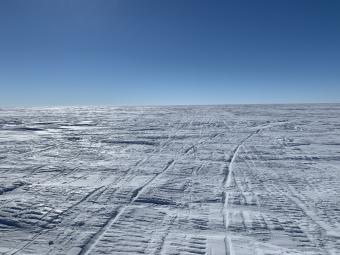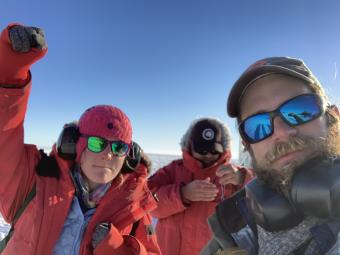Thinning ice sheets may drive sharp rise in subglacial waters
Mines' Matthew Siegfried and alum Chloe Gustafson helped create new model for how water moves through sediment under glaciers

A Colorado School of Mines professor helped create a new model for how water moves through the sediment under glaciers that shows that up to twice as much subglacial water might be draining into the ocean – potentially increasing glacial melt, sea level rise and biological activity.
Matthew Siegfried, assistant professor of geophysics, is one of five co-authors on the new paper, “Contemporary Ice Sheet Thinning Drives Subglacial Groundwater Exfiltration with Potential Feedbacks on Glacier Flow,” published Aug. 18 in Science Advances. Fellow co-authors were Alex Robel and Shi Joyce Sim of Georgia Tech, Colin Meyer of Dartmouth and Mines alum Chloe Gustafson of the U.S. Geological Survey.
"We are only just now coming to terms with how much water there is stored beneath the Antarctic ice sheet,” Siegfried said. “After only recently making the first observations of deeper groundwater aquifers beneath fast-flowing ice in Antarctica, we've now developed a model to start thinking about how important these deep reservoirs may be for the modern ice sheet. And based on the model results when inputting the latest NASA observations, it looks like groundwater flow may play a substantial role in moving heat and water to the base of the ice sheet."

While there are pre-existing methods to understand subglacial water flow, these techniques involve time-consuming computations. In contrast, the team, led by Robel and Sim at Georgia Tech, developed a simple equation, which can predict how fast exfiltration, the discharge of groundwater from aquifers under ice sheets, using satellite measurements of Antarctica from the last two decades.
“In mathematical parlance, you would say we have a closed form solution,” said Robel, an assistant professor in Georgia Tech’s School of Earth and Atmospheric Sciences. “Previously, people would run a hydromechanical model, which would have to be applied at every point under Antarctica, and then run forward over a long time period.”
Robel adds that while there is precedence for developing these kinds of theories for similar kinds of models, this theory is specific in that it is for the particular boundary conditions and other conditions that exist underneath ice sheets. “This is, to our knowledge, the first mathematically simple theory which describes the exfiltration and infiltration underneath ice sheets.”
One of the main arguments in the paper underscores the potentially large source of subglacial water — as much as double the amount previously thought — that could be affecting how quickly glacial ice flows and how quickly the ice melts at its base.
That source is exfiltration, which occurs when you take weight off aquifers and water starts flowing out of the sediment. Aquifers exist under large parts of Antarctica, but most research on exfiltration has focused on the long time scales of interglacial cycles, which cover tens of thousands of years.
There has been less work on modern ice sheets, especially on how quickly exfiltration might be occurring under the thinning parts of the current-day Antarctic ice sheet. However, using recent satellite data and their new theory, the team has been able to predict what exfiltration might look like under those modern ice sheets.
“There's a wide range of possible predictions,” Robel said. “But within that range of predictions there is the very real possibility that groundwater may be flowing out of the aquifer at a speed that would make it a majority, or close to a majority of the water that is underneath the ice sheet.”
If those parameters are correct, that would mean there's twice as much water coming into the subglacial interface than previous estimates assumed. But many of these subglacial sediment parameters have rarely been observed in Antarctica because of the difficulty of accessing the sediment beneath upwards of two miles of ice and the complications of the ice moving while trying to take measurements of the Earth below.
“Our paper both develops a new, exciting model and also serves as a flashing red light: there are still key aspects of this critical Earth system that we have yet to measure,” Siegfried said.
To read the full paper, “Contemporary Ice Sheet Thinning Drives Subglacial Groundwater Exfiltration with Potential Feedbacks on Glacier Flow,” go to science.org/doi/10.1126/sciadv.adh3693.




